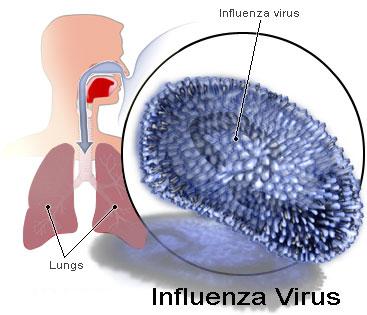Influenza Information
Click here to scroll to the list of available medications ↓
Influenza is commonly called the flu. Influenza is categorized into two types, A and B. The flu is a serious virus which attacks the nose, throat, and lungs of the victim and should be considered very contagious. While most people who contract the flu are able to withstand the symptoms, elderly people and people with suppressed immune systems may not survive the flu. Small children can end up with complications from the flu as well. Because the flu is a virus it can not be treated with antibiotics. The term “stomach flu” has nothing to do with the flu virus. The influenza virus attacks the respiratory system, not the digestive system.
Symptoms of the flu may at first come on like the common cold and progress rapidly. Symptoms of the flu may include high fever, headache, dry cough, muscle aches, loss of appetite, vomiting, dizziness, tiredness, sore throat, congestion, stuffy nose, nasal discharge, wheezing, croupy cough, shortness of breath, chills, fatigue, malaise, sweating, and the worsening of an underlying illness such as asthma or heart problems.

The flu is caused by a virus that is typically passed either through human contact or coming in contact with an object that someone with the flu virus has recently touched. The flu is considered highly contagious and those who are sick with the flu should stay at home while they recover. The flu is typically a winter illness and is contained in droplets from sneezing and coughing. The flu affects tens of millions of people annually, and approximately 36,000 people die every year from flu related complications.
Risk factors for the flu include people over the age of 60, children between the ages of six months and 2 years, pregnant women who are past their first trimester during the flu season, people who are hospitalized, people who live in long term care facilities, and people with chronic heart, lung, or kidney conditions, suppressed immune systems, or diabetes.
Diagnosis of the influenza virus includes a physical exam and possibly tests. A chest x-ray may be taken in order to rule out pneumonia, sputum cultures can be analyzed for the influenza virus, blood tests may include either a complete blood count or a blood culture to determine the presence of the flu virus. The flu is generally easy to recognize.
The flu can lead to complications especially for those who are more fragile or at a higher risk. Influenza can lead to pneumonia, ear infections, sinus infections, bronchitis, encephalitis which in an infection of the brain, and death. These complications rarely hit people who are otherwise normally healthy.

For people who at mild risk and are otherwise generally healthy treatment of influenza typically involves ample res, fluids, medications that help ease flu symptoms such as cough medicine and fever reducers while avoiding alcohol, tobacco, antibiotics, and aspirin, especially in children and teens as this may cause Reye’s syndrome. In recent years new antiviral medications have come out that can lessen the effects of the flu when taken within the first 48 hours of the flu’s onset. Consulting with a physician as soon as flu symptoms occur can determine the appropriateness of antiviral medications. Those who are weak or medically fragile should contact their physician immediately upon the arrival of flu symptoms.
A flu shot is a vaccine which can make the immune system more resistant against the flu. The flu shot is typically appropriate for people who are not currently pregnant, who are over 6 months in age, are not allergic to eggs, and who have never had adverse reactions to a flu shot in the past. The flu shot is an annual vaccine and needs to be acquired again the following year. There are different types of influenza vaccines available and physician or health care provider should be available to help explain the differences.
When recovering from the flu, rest is vital even after most of the symptoms have been alleviated. The flu is a fairly serious illness and even once a patient has returned to work or school, fatigue is likely to linger for up to a week afterward. If fatigue lingers for more than a week, a health care professional should be notified as this can be signs of a more serious illness.